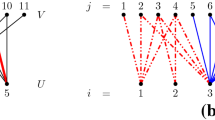Summary
A bipartite graph G=(A, B, E) is convex on the vertex set A if A can be ordered so that for each element b in the vertex set B the elements of A connected to b form an interval of A; G is doubly convex if it is convex on both A and B. Letting ¦A¦=m and ¦B¦=n, in this paper we describe maximum matching algorithms which run in time O(m + nA(n)) on convex graphs (where A(n) is a very slowly growing function related to a functional inverse of Ackermann's function), and in time O(m+n) on doubly convex graphs. We also show that, given a maximum matching in a convex bipartite graph G, a corresponding maximum set of independent vertices can be found in time O(m+n). Finally, we briefly discuss some generalizations of convex bipartite graphs and some extensions of the previously discussed techniques to instances in scheduling theory.
Similar content being viewed by others
References
Aho, A.V., Hopcroft, J.E., Ullman, J.D.: The design and analysis of computer algorithms. Reading, MA: Addison-Wesley, 1974
Booth, K.S., Lueker, G.S.: Testing for the consecutive ones property, interval graphs, and graph planarity using PQ-tree algorithms. J. Comput. System Sci. 13, 335–379 (1976)
Emde Boas, P. van: Preserving order in a forest in less than logarithmic time. Proc. 16th Annual Symp. on Foundations of Comp. Sci., Univ. of California, Berkeley, Oct. 1975, pp. 75–84
Emde Boas, P. van: Preserving order in a forest in less than logarithmic time and linear space. Information Processing Lett. 6, 80–82 (1977)
Gale, D.: Optimal assignments in an ordered set: an application of matroid theory. J. Combinatorial Theory 4, 176–180 (1968)
Gavril, F.: Testing for equality between maximum matching and minimum node covering. Information Processing Lett. 6, 199–202 (1977)
Glover, F.: Maximum matching in convex bipartite graph. Naval Res. Logist. Quart. 14, 313–316 (1967)
Hopcroft, J.E., Karp, R.M.: An n 5/2 algorithm for maximum matchings in bipartite graphs. SIAM J. Comput. 2, 225–231 (1973)
Lawler, E.L.: Combinatorial Optimization: Networks and matroids. New York, NY: Holt, Rinehart and Winston, 1976
Lipski, W.: Information storage and retrieval — mathematical foundations II (Combinatorial problems). Theor. Comput. Sci. 3, 183–211 (1976)
Lipski, W., Lodi, E., Luccio, F., Mugnai, C., Pagli, L.: On two dimensional data organization II. Fundamenta Informaticae 2, 227–243 (1977)
Tarjan, R.E.: Efficiency of a good but not linear set union algorithm. J. Assoc. Comput. Mach. 22, 215–224 (1975)
Author information
Authors and Affiliations
Additional information
On leave from the Institute of Computer Science, Polish Academy of Sciences, P.O. Box 22, 00-901 Warsaw PKiN, Poland
Also with the Departments of Electrical Engineering and of Computer Science
Rights and permissions
About this article
Cite this article
Lipski, W., Preparata, F.P. Efficient algorithms for finding maximum matchings in convex bipartite graphs and related problems. Acta Informatica 15, 329–346 (1981). https://doi.org/10.1007/BF00264533
Received:
Issue Date:
DOI: https://doi.org/10.1007/BF00264533




